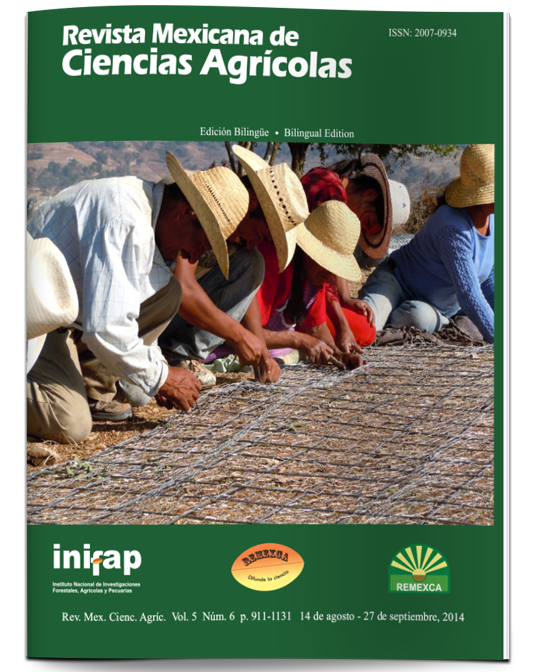Bean embryo morphology and its comparison between races Durango and Jalisco
DOI:
https://doi.org/10.29312/remexca.v5i6.882Keywords:
Phaseolus vulgaris L., seed, early vigorAbstract
In bean (Phaseolus vulgaris L.) the embryo is all the seed except the testa. In 2007, work was conducted in order to determine the ratio of the biomass from the embryonic axis complex (CEE, hypocotyl-root axis plus the two first leaves) and cotyledons and dimensions of CEE in contrasting varieties tolerant to drought, high and low yield, and the differences between bean races of Durango and Jalisco. For separation of the EEC, 20 seeds with biomass of 200, 260 and 320 ± 5 mg were selected. Seeds of 320 mg had total biomass of CEE (BTE) greater than 260 and 200 mg seed; this was due to greater total biomass of the first two leaves (BHS) and biomass of the hypocotyl-root axis (BHR). CEE separate from seeds of 320 mg had the highest leaf area of the first two leaves (AFPH) and length of hypocotyl- root axis (LHR), compared to 260 mg seed. The percentage of CEE in the embryo showed a reverse relationship with seed biomass. The cotyledons represented 98.4% of the biomass from the embryo and the CEE the rest. The drought-tolerant cultivar showed smaller width of hypocotyl-root axis (AHR) that the cultivar susceptible to drought; the high BTE from Pt Villa was due to its high BHR, meanwhile, the high BTE of FM M38 and Anita was due to a high BHR and BHS.
Downloads
Downloads
Published
How to Cite
Issue
Section
License
The authors who publish in Revista Mexicana de Ciencias Agrícolas accept the following conditions:
In accordance with copyright laws, Revista Mexicana de Ciencias Agrícolas recognizes and respects the authors’ moral right and ownership of property rights which will be transferred to the journal for dissemination in open access. Invariably, all the authors have to sign a letter of transfer of property rights and of originality of the article to Instituto Nacional de Investigaciones Forestales, Agrícolas y Pecuarias (INIFAP) [National Institute of Forestry, Agricultural and Livestock Research]. The author(s) must pay a fee for the reception of articles before proceeding to editorial review.
All the texts published by Revista Mexicana de Ciencias Agrícolas —with no exception— are distributed under a Creative Commons License Attribution-NonCommercial 4.0 International (CC BY-NC 4.0), which allows third parties to use the publication as long as the work’s authorship and its first publication in this journal are mentioned.
The author(s) can enter into independent and additional contractual agreements for the nonexclusive distribution of the version of the article published in Revista Mexicana de Ciencias Agrícolas (for example include it into an institutional repository or publish it in a book) as long as it is clearly and explicitly indicated that the work was published for the first time in Revista Mexicana de Ciencias Agrícolas.
For all the above, the authors shall send the Letter-transfer of Property Rights for the first publication duly filled in and signed by the author(s). This form must be sent as a PDF file to: revista_atm@yahoo.com.mx; cienciasagricola@inifap.gob.mx; remexca2017@gmail.
This work is licensed under a Creative Commons Attribution-Noncommercial 4.0 International license.



